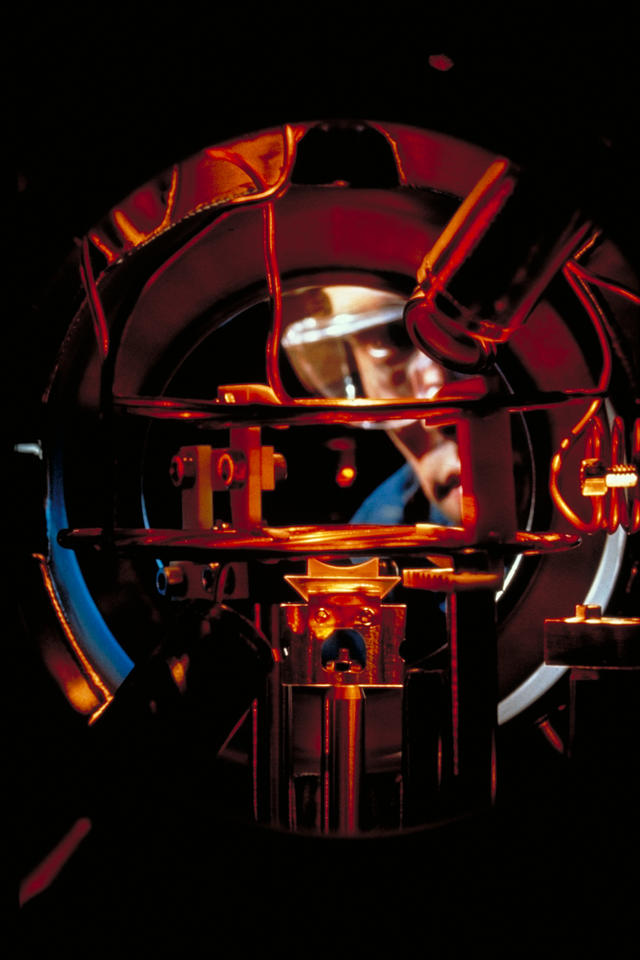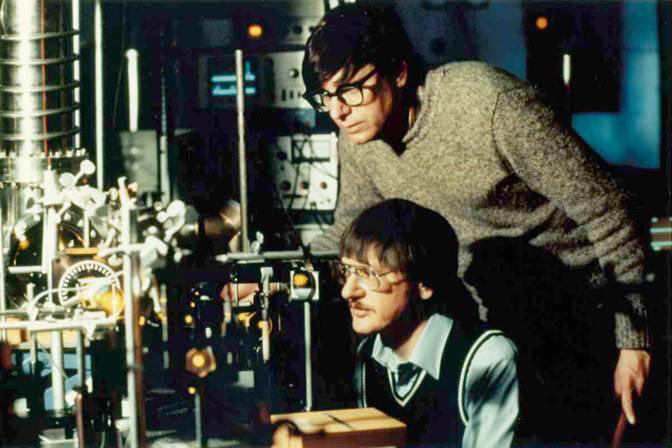Context of a Discovery: Bill Phillips
The idea that light can not only illuminate matter but also exert forces on it dates back to Scottish physicist James Clerk Maxwell, who in the late 1800s discovered that light is an electromagnetic phenomenon. Light’s force on macroscopic objects was measured experimentally around the turn of the 20th century by Pyotr Lebedev in Russia and Ernest Nicols and Gordon Hull in the U.S.; Otto R. Frisch was the first to demonstrate it for atoms, in 1933.
In 1968, Soviet physicist Vladilen Letokhov proposed using light forces to trap atoms. In the 1970s, Arthur Ashkin at Bell Laboratories in Murray Hill, New Jersey, showed how forces exerted by laser light could trap large “macroscopic” objects that could be seen with the naked eye. Ashkin’s method also suggested a way to trap atoms. Only in 1975, however, did Theodor Hänsch and Arthur Schawlow of Stanford University suggest how laser light could be used to cool gaseous atoms to the point where they could be held nearly motionless in a trap. Independently, but in the same year, David Wineland (who would later move to NIST-Boulder and share the 2012 Nobel Prize in physics) and Hans Dehmelt of the University of Washington proposed using lasers to cool ions that were held in an electromagnetic trap, a trapping technique that was already well established.
Trapping neutral atoms turned out to be more challenging. Normally, gaseous atoms and molecules (for example, in air at room temperature) move with typical speeds of about 300 meters per second, or roughly the speed of sound, and constantly crash into their neighbors; roughly 10 billion billion particles occupy each cubic centimeter of air.
Scientists realized, however, that atoms cooled to a few millionths of a degree above absolute zero would slow to a crawl. That’s because the temperature of a group of particles is a measure of the average kinetic energy of those particles. But cold alone wouldn’t be enough. For the applications Phillips and others had in mind, such as atomic clocks, the atoms had to remain a gas. When condensed into liquids or solids, as would happen during ordinary refrigeration, atoms’ energy levels shift and broaden. Such atoms would not very useful as the basis for NIST’s primary frequency standards (nor for many of the subsequent applications that were as yet undreamed of). Laser cooling was the key to making gaseous atoms cold.
Wineland moved to NIST’s Boulder lab in 1975. In 1978, he was among the first to successfully cool and trap ions (in this case, atoms of positively charged magnesium).
Phillips was inspired by Wineland’s work to cool neutral atoms. He understood that cooling and trapping neutral atoms would be harder than trapping ions because neutral atoms, lacking electric charge, are less affected by electric and magnetic fields, and therefore, harder to trap. Techniques proposed in 1975 involved firing many laser photons (particles of light) against atoms, which would be like rapidly tossing hundreds and hundreds of pebbles to stop a rolling stone. It had the potential to work, because photons, despite having no mass, do have small amounts of momentum, and in turn, they can change the momentum of atoms that absorb the photons.
But it was not as simple as just shining a laser beam at a bunch of atoms. The electrons that orbit the cores of atoms can be at certain energies but not others. They make transitions between energy levels by absorbing or emitting photons. So atoms are like sharply tuned radios, capable of absorbing and re-emitting certain frequencies of light but not others. If the atoms are moving, the frequency or color of the light the atom “sees” would shift by an amount proportional to the velocity of the atom. Laser cooling would work, physicists argued in 1975, because atoms moving toward a laser of just the right color would absorb the onrushing photons, slow down and then re-emit photons in all directions. The momentum change imparted to the atom from the emitted photons would average to zero.
Phillips calculated that he could nearly stop a 600˚C beam of sodium atoms, moving at about 1,000 meters per second, with about 30,000 photons. The deceleration would occur over a distance of about a meter and in a few thousandths of a second.
But there was a further complication: The frequency of light that an atom can absorb depends not only on its electrons’ energy levels, but also on its velocity. As Phillips’ atoms slowed down, they would quickly become transparent to the laser light because of the Doppler effect—the same phenomenon that alters an ambulance siren’s apparent pitch as it approaches and then speeds past.
There were several ways to deal with the Doppler effect when trying to slow atoms in an atomic beam. One, proposed by Soviet physicists at the Institute of Spectroscopy, was to raise the frequency of the laser’s light to compensate for the Doppler effect as the approaching atoms slowed down, a technique known as “chirp cooling.” Another, devised by Phillips, was to influence the target atoms such that they would continue to absorb light of a constant frequency despite their deceleration. This hinged on something called the Zeeman effect, discovered in the late 1800s, which describes how a magnetic field can shift the energy levels of electrons in an atom, and thus, the frequencies of light that the atom can absorb and emit.
Phillips and colleagues chose the second approach. They sent their sodium atom beam through a solenoid, which is a current-carrying wire wound in a helix. The arrangement creates a magnetic field inside the coil, parallel to its axis. The researchers designed the solenoid so that the magnetic field changed in a precise way along its length. With their design, the atoms were able to absorb the laser light as they slowed.
“I often say it’s the one good idea I had,” Phillips jokes. “Everything else was just luck, but this was actually a good idea.”
Phillips and his colleagues wound their solenoid by hand, and used various tricks to keep it cold and prevent it from shorting out. One was a white silicone grease that helped heat flow away from the wire.
“The grease was about the same color and consistency as the diaper rash ointment I was then using on my baby daughters, so there was a period of time when, whether at home or at work, I seemed to be up to my elbows in white grease,” Phillips recalled in his Nobel lecture.
Phillips’ team had slowed a beam of sodium atoms nearly to rest and reduced its effective temperature to less than 100 millikelvin, or thousandths of a degree above absolute zero. It was one of the major breakthroughs that would lead to the 1997 Nobel Prize.
“Bill’s one of these people who is inquisitive by nature. He’s inquisitive about everything. He loves having a discussion. He loves understanding nuances; he loves getting into the details.”
– Carl Williams, former deputy director, NIST Physical Measurement Laboratory





